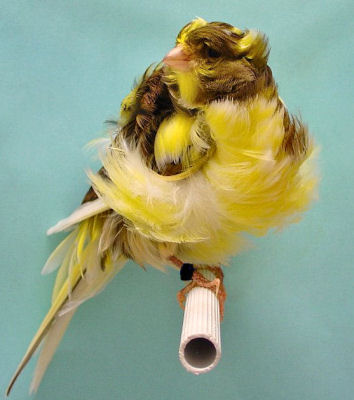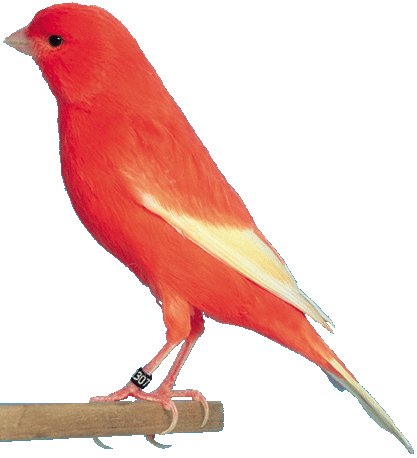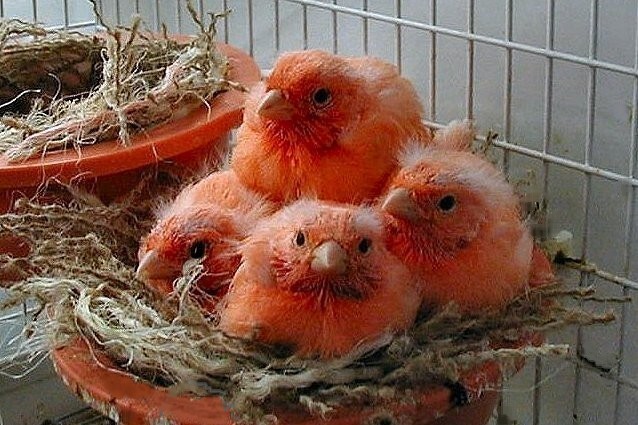
Country of Origin: Canary Islands
Size: 12 cm in length from the beak to the tip of the tail.
Life span: up to 10 years
Scientific Name: Serinus canaria
MUTATIONS
Mutations Based on the "Color" Bred Canary
Green (Wild Type): Darkest black and brown melanin shade in yellow ground birds.
Yellow Melanin: Mutation showing yellow ground color with brown and black pigment.
Yellow Lipochrome: Mutation creating the loss of brown and black pigment leaving yellow ground color.
Red Factor Melanin: Mutation showing red ground color with brown and black pigment.
Red Factor Lipochrome: Mutation creating the loss of black and brown pigment leaving red ground color.
Blue Factor: Darkest black and brown melanin shade in white ground birds.
Dominant White: Dominant mutation creating the loss of black and brown pigment leaving white ground color.
Recessive White: Recessive mutation creating the loss of black and brown pigment leaving white ground color.
Silver Factor: Mutation that combines white ground color with brown and black pigment.
Pastel Factor: Sex-linked gene that reduces the intensity of black pigment in feathers.
Ivory Factor: Sex-linked gene that reduces the strength of overall color.
Dimorphic Factor: Sex-linked gene providing visual differences in gender such as the Mosaic.
Opal Factor: Autosomal recessive gene which inhibits brown pigment and dilutes black to gray.
Cinnamon: Sex linked mutation which eliminates all black pigment on a yellow ground bird.
Agate Series: Sex-linked gene which inhibits brown pigment but shows black/grey pigment.
Fawn: Sex linked mutation which eliminates all black pigment on a white ground bird.
Isabel Series: Color mutation combination of Brown and Agate.
Satinet: Sex-linked gene that produces pigment in back and flank markings only.
Ino: Autosomal recessive mutation causing red eyes on a bird with brown pigment.
Phaeo: Mutation which inhibits black pigment and concentrates brown pigment on feather edges.
Albino: Mutation causeing total lack of all pigment.
Onyx: Maximum expression of the black pigment and inhinbits brown pigment.
Eumo: Mutation that inhibits brown pigment and reduces black pigment.
Mutations Based on the "Type" Bred Canary
Border Canary: Selectivley bred English/Scottish Canary that stands at a 60 degree angle.
Gloster Canary: Selective bred combination of Border Canary and Crested Rollers.
Stafford Canary: Selectivley bred cross between Red-Factor and Gloster Canaries.
Norwich Canary: Selectivley bred for large, bulky size and puffiness of the feathers.
Fife Canary: Selectively bred miniature Border Canaries which are no more than 12 cm.
Scots Fancy Canary: Selectively bred Scottish Canaries produced for their akward stance.
Belgian Fancy Canary: Selectively bred Belgian Canaries produced for their akward stance.
Parisian Frill Canary: Selectively bred for its frilled feathers and large size of up to 21 cm.
Dutch Frill Canary: Selectively bred for its frilled feather structure.
Yorkshire Canary: Selectively bred combination of Lancashire, the Belgium and the Norwich.
Lizard Canary: Selectivly bred French Canaries produced for the scale-like spangled feathers.
Mutations Based on the "Song" Bred Canary
German Roller Canary: Selectivley bred German Rollers that sing with their beak closed.
Belgian Waterslager: Selectivley bred Belgian Rollers which can imitate the sound of rolling water.
Spanish Timbrados: Selectivley bred Spanish Rollers which can make chattering sounds and metallic tones.
American Singer Canary: An American combination of 2/3 Roller canary and 1/3 Border canary (1942).
Description
While the first color to pop into your head may be yellow, there are many different varieties of Canary in just as many different colors. With selective breeding, many new color mutations pop up everyday, such as bronze, white, and red.
Temperament
Most Canaries are somewhat timid and shy little birds. Unlike larger bird species, they don't usually do well with being handled, although exceptions do exist. Canaries are charming birds nonetheless, and many enjoy watching and interacting with their owners from the comfort of a large flight cage. These birds can be very territorial, so use caution if keeping more than one per cage -- dominant behavior can be hard to control and can lead to an unforunate situation for a submissive bird.
Diet
Canary seed mixture, with plain canary seed and red rape, plus other seeds such as niger, and greenstuff.
Special Needs
If interested in a singer, obtain a cock no matter what the breed. Housing two birds in separate cages in same room often stimulates competition, encouraging both to sing for long periods. Do not house two cocks together because they are liable to fight.
Excercise
Canaries require plenty of exercise and should have a large cage that they can fly around in daily. Also make sure to provide plenty of safe toys for these little beauties to play with -- they get bored easily!
Cage Life
Can breed in home if in a breeding cage with nesting pan attached inside. Pan should be lined with piece of felt and hen provided with safe nesting material. Lays 4 eggs, 1 each day. Remove the first 3, store in matchbox lined with cotton wool, replace them with dummy eggs. On fourth day, restore first 3 and hen will start to incubate. This ensures they will be of similar age when hatched, more likely to survive. Remove the cock bird just before laying to allow hen to rear chicks on her own. Alternatively, the pair can be left together throughout. Incubation 13 days, fledging another 13. Offer rearing food throughout this period, introduce seed gradually.










































